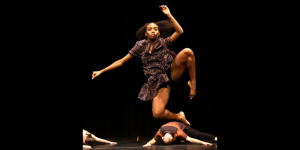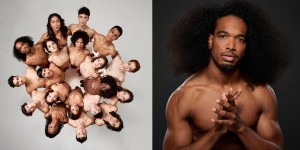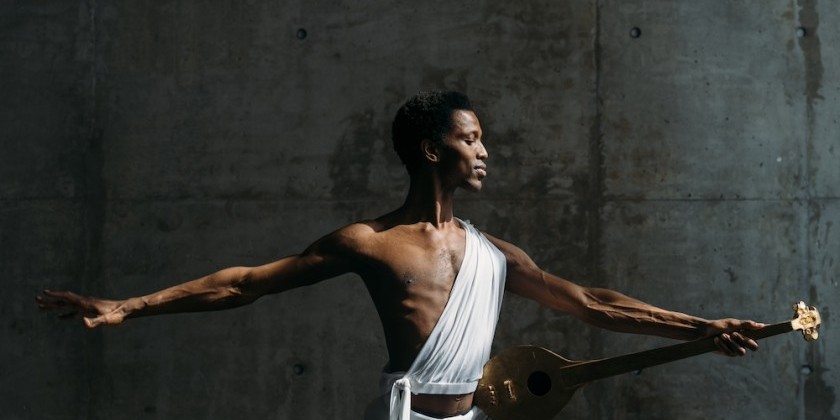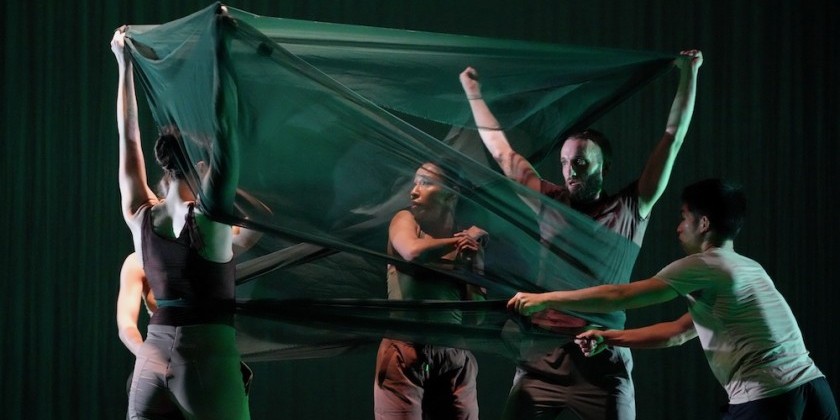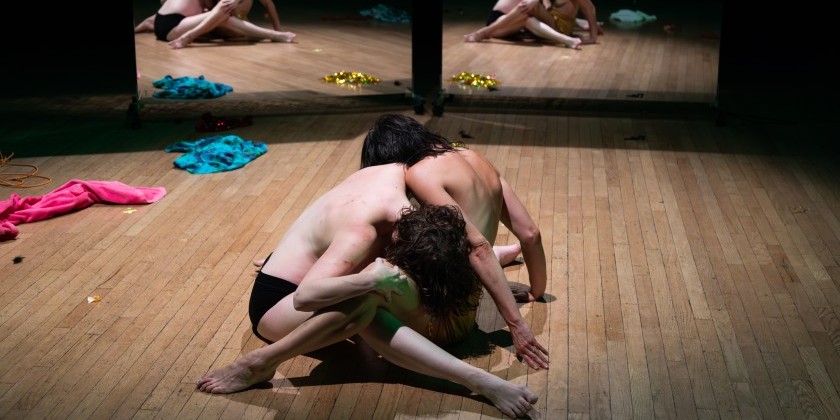IMPRESSIONS: Gibney Company at The Joyce Theater with Choreography by Rena Butler, Alan Lucien Øyen, and Sonya Tayeh

November 3, 2021
Artistic Director, Founder, and CEO: Gina Gibney
Company Directors: Nigel Campbell & Amy Miller
Performance: Gibney Company
The Game is Rigged
Choreography: Alan Lucien Øyen // Set and Lighting Design: Martin Flack
Music: Nils Frahm, Snorri Hallgrimsson, Johann Johannsson, Noze, Jocelyn Pook, Richard Skelton, Olga Wojciechowska
Oh Courage!
Choreography: Sonya Tayeh // Associate Choreographer: Jenn Freeman
Original Music and Live Performance: The Bengsons // Set Design: Rachel Hauck
Lusus Naturae
Choreography and Text: Rena Butler // Sound Design: Darryl J. Hoffman
Gina Gibney, visionary mover and shaker, has established an NYC dance complex that centers on social justice practice. Equity and sustainability are embedded in every facet of the Gibney Company, the Gibney Center, and the Gibney Community. Upon receiving a $2 million gift by philanthropist Andrew A. Davis in 2020, which Gibney describes as “like a lightning bolt,” the company expanded.
Now a repertory company, it doubled in size by adding six new dancers and changed its name from the Gibney Dance Company to the Gibney Company to reflect its broadening brand. The company encourages Artistic Associates (formerly known as dancers) to develop an entrepreneurial good works component funded by the company.

|
Gibney Company’s debut performance at The Joyce Theater. Pictured (left to right): Jacob Thoman, Jie-Hung Connie Shiau, and Jake Tribus in Alan Lucien Øyen’s The Game Is Rigged. Photo by Erin Baiano courtesy of Gibney. |
The company’s 30th Anniversary and debut season at the Joyce Theater coincided. To honor these milestones, the Gibney Company boldly commissioned three world premieres from Norwegian Alan Lucien Øyen in his inaugural NYC appearance, Gibney Choreographic Associate Rena Butler, and Tony award-winning Sonya Tayeh. The Gibney ideology infuses the work.
Alan Lucien Øyen’s The Game Is Rigged begins with promise. Leal Zielińska enters from behind a tall plywood set at the back of the stage. A man crouches against the plywood and observes her. “I’ve been meaning to ask you something,” she ventures before lunging, turning, and lowering to a squat; “I don’t know where to go from here.” As if slapped, she falls back. She says, “The game is rigged,” and raps her chest. “Why are you here?" She crabwalks, then backbends with her upside-down face looking out: “Don’t forget to smile.” Jake Tribus kisses her neck. “Gotcha.”

|
Gibney Company’s debut performance at The Joyce Theater. Pictured (left to right): Jake Tribus, Marla Phelan and Kevin Pajarillaga in Alan Lucien Øyen’s The Game Is Rigged. Photo by Erin Baiano courtesy of Gibney. |
For the next 40 minutes, primarily solos, duets, and trios enter and exit. While the deadpan, affectless text portrays sometimes sullen, other times anxious portraits of Millennials, the finely wrought movement holds interest. The characters, the text, and the illustrative movement do ring true. However, the drone of the angst-driven monologues and the sameness of the movement quality lends an evenness to the performance. The unremitting questioning of motivation and misstep adds up to shallow self-preoccupation with no recourse. The dance gave no reason to care for these characters. The hope is for real emotion, the kind that moves forward toward insight. But in The Game Is Rigged, we’re all stuck and staying there.
In contrast, The Bengsons, an uplifting indie-folk music couple, sang their original composition in Sonya Tayeh’s Oh Courage!, exhorting the Artistic Associates to dance with daring and optimism, bywords of the Gibney Company. Housed under four giant light stands, Abigail Bengson, like a Pentecostal preacher, belts, “I’m telling to you, palms open."
With floating arms, Butler scampers while turning up and down varied sizes of stacked speakers that bifurcate the tent-like space. Abigail continues: “You think you are dying, but you’re being born,” as Shaun Bengson accompanies on keyboards, trumpet, accordion, and voice. Like a sanctuary, these speakers are a staging area for the eight dancers who mark time by gesturing in place or by perching on the speakers. They witness the dancing on the open stage while they wait to venture forth. As a group, they kneel and roll, then move upright in unison. Dancers attach to one another front to back and resemble the movement of a caterpillar.

“Courage, courage,” Abigail sweetly sings, “until breath gives out.” Later, the dancers march in unison, run across, and slide off the stage. The Bengsons: “Shake these bones!” and “Gather your sinew!” Intones Abigail, “Hope is an action!” as the dancers come together in a tight circle, reaching upward in a teepee of light. Again and again, Abigail encourages, “Hope is an action!” The eight dancers spread and face upstage. They jump on their left legs as their right legs swing forward and back, forward and back, keeping time as the curtain lowers.
Lusus Naturae by Rena Butler advances a different truth. I saw this dance as probing the displacement and demise of the natural world with the gorilla as a stand-in for its next of kin, the human. Program notes explain that Butler examines colonization by decolonizing the self through an abstracted narrative of the film, King Kong. Perhaps the two ideas intersect.

Gibney Company’s debut performance at The Joyce Theater. Pictured (clockwise from top): Jesse Obremski, Jake Tribus and Alexander Anderson in Rena Butler’s Lusus Naturae. Photo by Erin Baiano courtesy of Gibney.
The dance opens with Butler’s voiceover announcement, “Ladies and gentlemen, boys and girls, we’re going to exhibit a creature that’s supposed to be extinct. The rarest beast on earth, the one and only…” A circus-like trio — Marla Phelan, Kevin Pajarillaga, and Jacob Thoman — form a stacked shape by crawling over one another. They unstack and re-form into loping beasts. The threesome walks on their hands as they kick their legs behind them. Mouths open, their tongues swipe the air. Pounding their chests and grabbing their crotches, the beast in each of them is fully expressive. Sweating and breathing heavily, at the front of the stage, they face down the audience and karaoke-style yell lines from Missed Calls by the hip hop duo Earthgang: “With me, myself and my demon semen, Canine teeth got me feline fiendin’.”
As the dance winds down, a gripping story of a girl falling into the gorilla cage is recounted. “The gorilla showed an astounding sensitivity for human life. This is a rare glimpse into this extraordinary animal.” (Text by Butler.) Lights fade as Phelan is lifted onto the shoulders of the men — a hopeful sign for gorillas and for humans.

What is most striking about the Gibney Company is the prowess of the Artistic Associates. They dive into the space with abandon. They partner with ease. Hyper-mobility defines their bodies. A fluid spine, pliable thigh sockets, wide lunges, seemingly impossible back arches, soft arms, and untroubled extensions abound. To experience their dancing is to feel their and the Gibney Company’s fulsomeness.





